Shaded areas in your yard often present a challenge when it comes to growing a lush, thriving lawn. Dealing with dense shade from tall trees or structures often leads to common issues like thinning grass, bare spots, and slowed growth.
In my experience, planting high-quality, shade-tolerant grass is the best course of action.
Quick Answer
The best grasses that grow in shade include:
In this article, you’ll learn the pros and cons of each of these grass varieties to help you make the best choice for your needs. Rather than planting a single species, consider mixing grass seeds to achieve a balance suitable for both sunny and shaded areas.
Grass That Grows in Shade
When establishing a new lawn – using grass seed, sod, or hydroseed – shade and sunlight conditions are a major factor. Some lawn grass types do well in full sunlight while others can withstand shade and thrive. Here’s a quick guide on selecting the right type of grass for your lawn.
Tall trees and buildings near your yard are a clear sign there will be some sort of shade covering your lawn for a considerable amount of time per day. Therefore, it is very important to know the sunlight requirements for different lawn grasses to guide you in choosing the right species to plant.
Here are the best shade-resistant grasses to grow in a lawn with low light conditions:
1. St. Augustine Grass
St. Augustine grass is a warm-season lawn grass that is known to do well in shaded areas. This does not mean that it will always thrive in long, deep-shaded areas.
It still has some sunlight requirements although not as long exposure as other options like Bermuda grass. (See my detailed guide on how to choose between St. Augustine and Bermuda grass here.)
There are some cultivars of St. Augustine grass that are highly resistant to shade. These include Sapphire, Bitter Blue, Palmetto, and Seville. These cultivars also thrive well in full sunlight. 4 – 5 hours of direct sunlight is enough, making them the best grass to grow in partially low sunlight conditions.
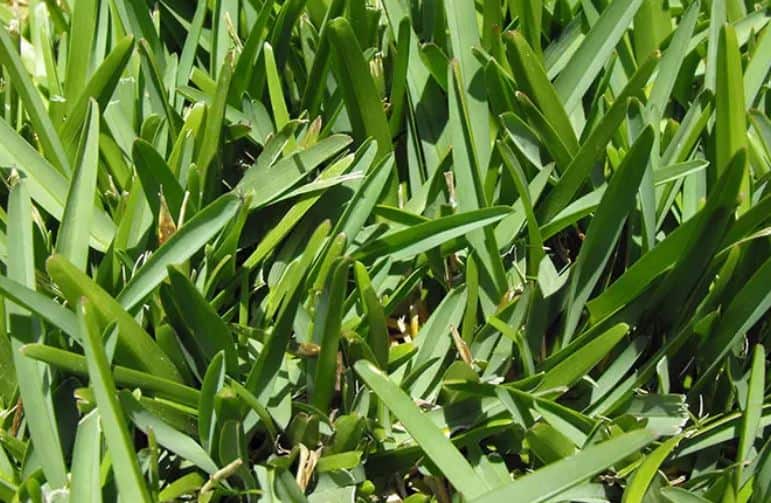
St. Augustine Grass Sunlight Requirements
The most common cultivar of St. Augustine grass is Floratam. It is widely found in the southern United States. However, it is not the most shade-resistant type to grow for such adverse conditions.
- Floratam requires at least 6 – 8 hours of direct sunlight to thrive well.
- Palmetto, Seville, and Sapphire cultivars require a minimum of 4 – 5 hours of direct sunlight per day.
Deprivation of light can show problematic symptoms such as thinning, disease attacks, and stunted growth.
If your lawn is under full shade, I still wouldn’t recommend growing any of these turfgrasses. You can, however, improve the survival ability of St. Augustine grass by cutting the canopy above the lawn to allow a good amount of sunlight to penetrate underneath.
2. Zoysia Grass
You can grow Zoysiagrass as a shade-tolerant species. However, it still prefers the sun and we cannot say that it is a shade-loving grass. Its low-light tolerance is better than that of Bermuda grass, so between the two, it would be the right pick. You can successfully grow Zoysia in subtropical areas, such as Florida.
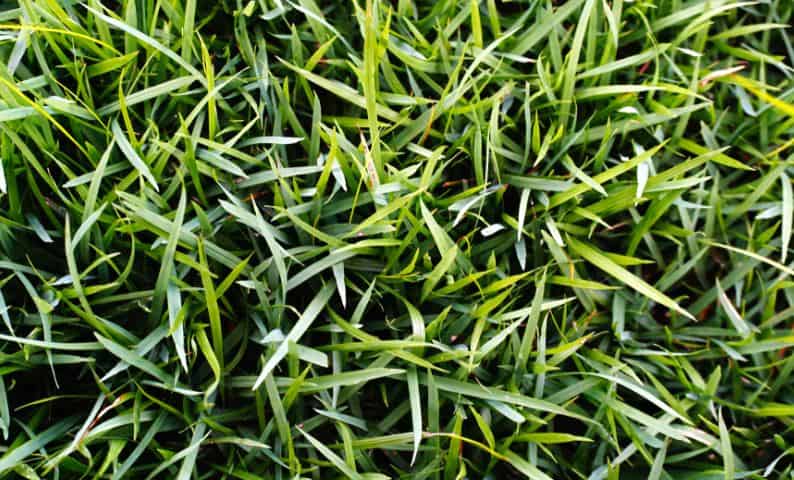
Zoysia sunlight requirements
Being a warm-season turfgrass, Zoysia will require at least 3 – 4 hours of direct sunshine to thrive really well. This makes it a great choice for lawns with partial shade – such as those near tall buildings and distant tall trees.
Many sources recommend Zoysia cultivars with fine blades as the best shade-tolerant turfgrasses. A great fine-bladed Zoysia variety that is extremely shade-tolerant is Zeon.
It is usually planted on golf courses and sports fields. Another fine-bladed shade-loving grass you can choose is Geo Zoysia. It produces a deep green turf that’s tolerant to wear and foot stress.
Some cultivars such as Emerald Zoysia may not be the best for long hours of shade because they grow very slowly and can be choked out by aggressive weeds such as crabgrass.
Zoysia does not tolerate shade as well as St. Augustine grass, but it is better at surviving low sunlight conditions compared to Fescues and Rye.
3. Fescue
Fescue is a great grass that grows in shade but that does not mean it will thrive well in densely shaded areas such as those with dogwoods. However, if you’re looking for cool-season grass for shade, tall fescue would be excellent to plant in your lawn.
Turf-type tall fescue is shade-tolerant and can also grow well in drought conditions as well as low-fertility regions. It is, however, worth noting that even though fescue grass is shade-resistant to some extent, it still prefers full sun for optimum growth and coverage.
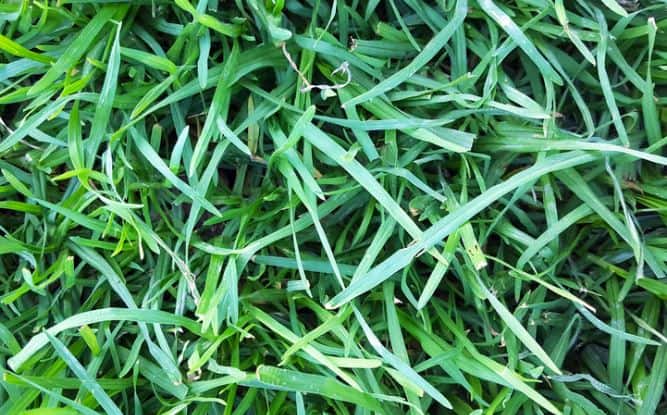
Fescue sunlight requirements
Fescues require 4 – 6 hours of filtered or dappled sunlight for healthy growth. However, even this alone may not be enough to make it grow well near trees.
Ensure proper care, such as mowing higher, watering adequately whenever the ground is dry, and applying moderate amounts of nitrogen fertilizers to give fescue grass a better chance of surviving low sunlight conditions.
If you do not want to grow tall fescue, you can opt for red fescue, fine fescue, or Chewings fescue which are good cool-season types.
Fine fescue is commonly grown in the central and northern United States. The fine blades of this turfgrass make it suitable for growing in shady areas.
Affiliate links and images pulled from the Amazon Product Advertising API on: 2025-06-29
4. Rye Grass
Not all varieties of Ryegrass tolerate shady areas very well. The highly recommended grass type here for low sunlight conditions is Perennial Ryegrass. This cultivar does not require extensive hours of direct sunlight like other varieties.
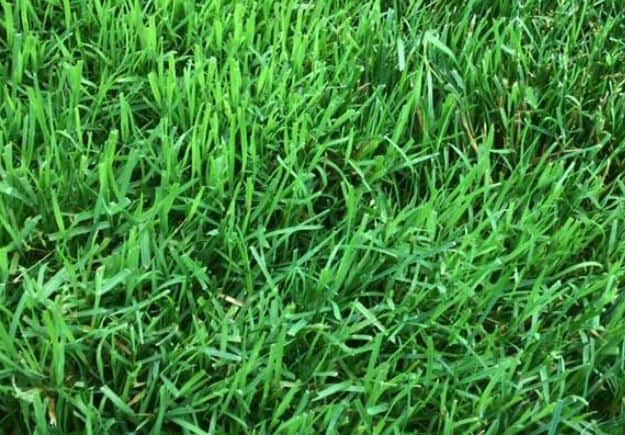
Sunlight requirements for Perennial Ryegrass
- Plant ryegrass if your lawn will receive at least 4 – 5 hours of direct sunlight.
- If your lawn has filtered sunshine or dappled daylight, perennial ryegrass will not thrive well.
Remember that rye is a cool-season turfgrass and will prefer climates where temperatures remain between 68 and 77 degrees Fahrenheit. Its shade tolerance persists even in summer if there’s a little moisture on the lawn.
It is not uncommon to find ryegrass dying in the summer when temperatures are scorching – soil temperatures above 90 degrees.
5. Bluegrass
The particular variety of bluegrass that’s excellent for shade is rough bluegrass. Rough bluegrass is best adapted to wet, cool, and shady areas. If you’re planting a lawn in hot temperatures, you might want to skip rough bluegrass because, during summer, it dies off leaving bare spots in your lawn.
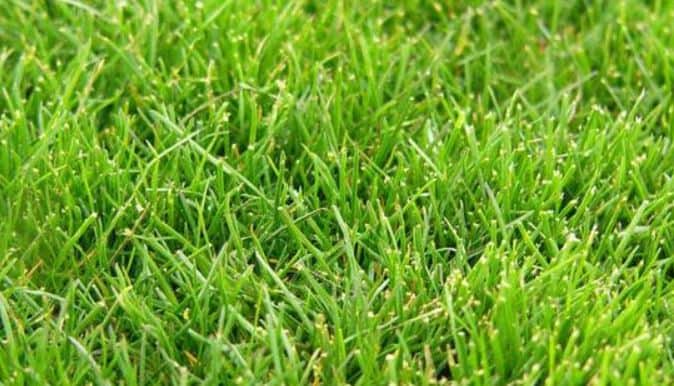
Rough bluegrass is aggressive in shady areas especially under trees so long as the climate is cool and the soil moist. It requires about 4 hours of dappled sunlight daily to thrive.
When discussing bluegrass, it is hard to leave out Kentucky Bluegrass. It is a great option for cool-season lawns. Kentucky Bluegrass seed lawns can still grow well in partial shade but will still require some amount of direct sunlight.
6. Centipede Grass
Centipede grass is one of the few warm-season grasses that boasts remarkable tolerance to heat but on the downside features a relatively shallow root system.
One of the noteworthy features of centipede grass is that it doesn’t typically require dethatching and is more shade-tolerant than many other warm-season grasses including bermudagrass.
Adding to this, centipede grass requires less mowing and fertilizer and can be planted from seed or sod. See my detailed article on how to plant centipede grass.
This low-maintenance grass thrives in relatively low-quality soil and can impede the growth of invasive weeds. Centipede grass does offer some shade tolerance but grows best in full sun exposure.
7. Carpetgrass
Carpetgrass may come across like a weed depending on whether you planted it on purpose or not but grows well in the southern part of the United States.
There are two main types of carpetgrass namely narrowleaf carpetgrass and broadleaf carpetgrass, both of which can survive in bad soil conditions.
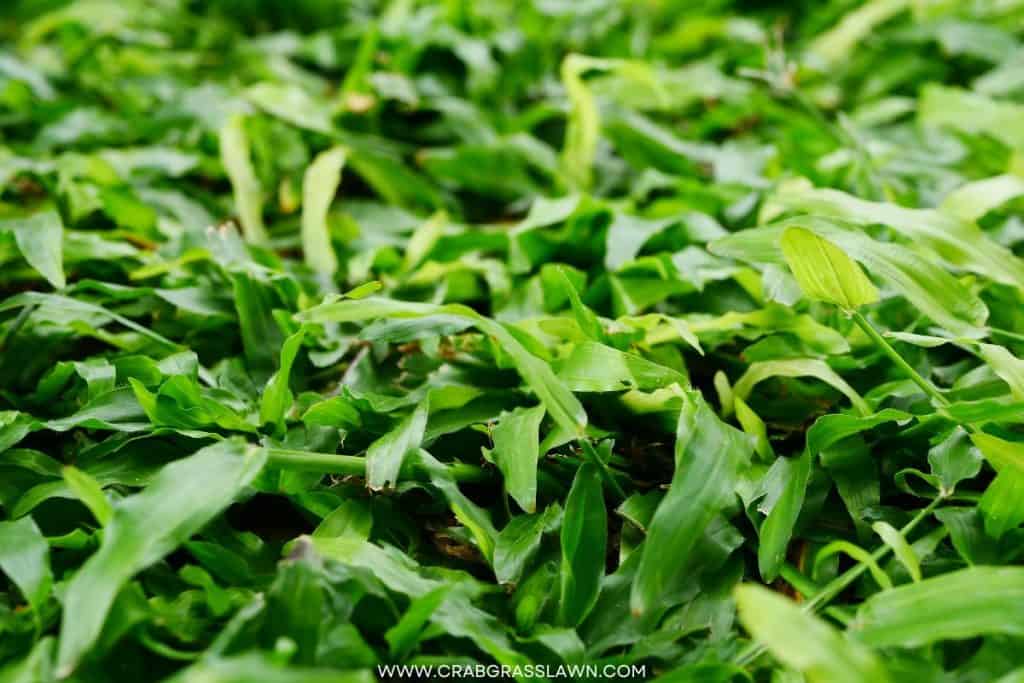
Another area where carpetgrass shines is for its shade tolerance, making it a good choice for people who live in the south. It does however need some sunlight but can survive more than most other warm-season grasses including bermudagrass.
Your local park or roadside is layered with carpetgrass and for many good reasons including the fact that it requires little to no fertilizer, crowds out weeds, and helps with erosion control. Did you know that common carpet grass is also a managed pasture grass in some localities?
8. Kikuyu
Another warm-season grass that spreads quickly, kikuyu thrives in areas with moderate temperatures and does relatively well in shady lawns.
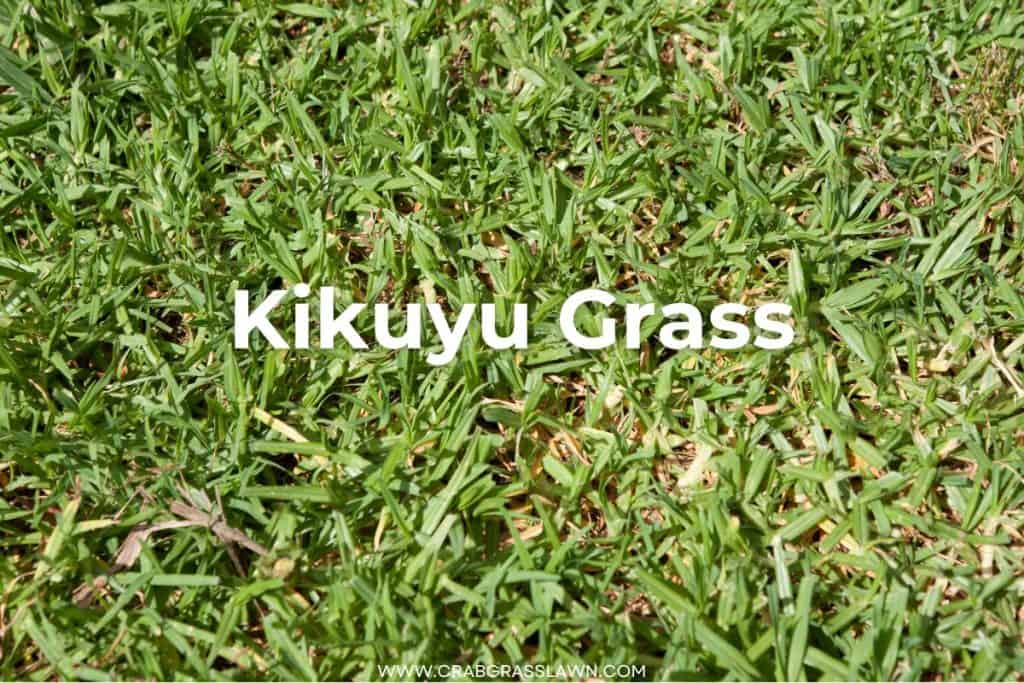
It boasts a vigorous growth habit and is often considered as a weed in some coastal and inland areas of California.
Kikuyugrass is not often established as a turfgrass and was in fact once considered as a weed. On a brighter note, kikuyugrass can tolerate low fertility and high heat and can recover from drought conditions.
Is There a Full Shade Grass Species?
When shopping for grass seed, it is important to choose a shade-tolerant species that is well adapted for your region. Grass seeds that are adapted for Texas may not do well when planted in regions far from such environments.
On this list, the most shade-tolerant grass can survive with barely 4 hours of direct or dappled sunlight. So, is there something like a full-shade grass species?
It is not possible to find full-shade grass seeds because all plants require sunlight for photosynthesis. If the area in your yard where you want to establish a lawn is fully covered with shade, prune the branches of trees to allow penetration of some sunlight beneath. It will allow your grass to grow and thrive better.
How to Get Grass to Grow in Shade
Although the grass species and cultivars we’ve discussed above can grow under trees and low light conditions, it is important to observe a few care tips. These will help your grass grow faster, thicker, and fuller.
Any turfgrass with high shade tolerance still requires diligent care to flourish. Take for example areas where grass grows under trees. It will have to compete with the roots of those trees for nutrients, oxygen, and water.
Here are tips on how to get grass to grow better in areas with shade:
- Reduce stress on the grass – minimize foot traffic in areas of your lawn that receive less sunlight per day.
- Increase the mowing height – Mow your grass higher than you normally would to allow more surface area on the grass blades for maximum absorption of the limited sunlight.
- Treat lawn diseases promptly – Exposure to long hours of shade means your lawn remains wet for long during the cool seasons. This leaves your lawn prone to fungal diseases. Pay extra attention to the signs on the grass under low-light conditions and treat any diseases as soon as you notice them.
- Seed or overseed each fall – Overseeding heavily will help your turfgrass grow denser than weeds. I would recommend you overseed with 6 – 8 lbs of grass seed per 1000 square feet to achieve a great cover in low light conditions.
- Plant a dense shade mix grass seed – Even if your lawn receives dappled sunlight each day, one of the best ways to get grass to grow in shade is to use a shade mix grass seed.
A mix of shade-tolerant variety and self-repairing grasses can keep your shaded areas well-covered.
A good example is the Scotts Turf Builder Grass Seed Dense Shade Mix which does well under trees with as little as 3 hours of direct sunlight per day. There are several different ways to apply herbicides including convenient backpack sprayers.
Other than observing the above tips for growing a dense cover of turfgrass in shady areas of your lawn, remember to get rid of stubborn weeds such as crabgrass and quackgrass to prevent them from choking out your preferred grass.
Also, feed grass in shaded areas a little more than the areas with full sun. The reason for this is that the competition for nutrients is higher in this area and standard feed amounts may not be enough to grow a thick lawn under shade.
What Is the Best Shade Grass in the Southern States?
St. Augustine is the best shade-tolerant warm-season grass in the United States but the downside is that it can’t be bought as seed. Next up is zoysia grass – a turfgrass that is known for its ability to stand up to heat, drought, and heavy foot traffic.
What Is the Best Shade Grass in the Northern States?
When choosing the best shade grass in the northern states, you’ll be spoilt for choice given the myriad options available including fine fescue, St. Augustine, zoysia, perennial ryegrass, bluegrass, and centipedegrass.
What Is the Best Shade Grass in the Transition Zone?
If you live in the transition zone, you can choose from St. Augustine, bluegrass, centipede grass or fine fes fescue.
Tall and Ornamental Alternatives
When normal turfgrass fails or becomes tough to maintain in shady areas, you can choose to plant tall and ornamental grasses. These are basically used for decorative purposes and can keep away the ugly bare spots in areas of your lawn that are covered with shade.
Some of the best ornamental grasses for shade include:
- Japanese forest grass
- Blue grama grass
- Korean feather reed grass.
- Autumn moor grass.
- Fall-blooming reed grass.
- Liriope
- Little Miss Maiden Grass
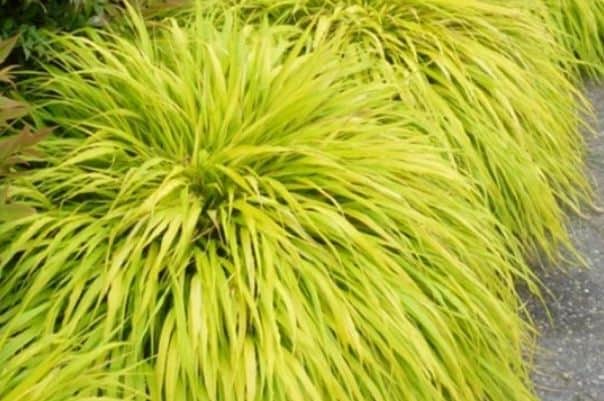
Most of these grow fast, forming beautiful arching clumps with foliage. The leaves are sometimes variegated. The foliage coloration is what makes these grasses a great choice for decorating shady areas of your lawn.
FAQs
Best Grass Seed for Shade and Poor Soil
The best grass seed for shade and poor soil is Kentucky bluegrass, perianal ryegrass, and fescue grass.
Sun and Shade Grass Seed
You can choose from tall fescue, perennial ryegrass, or even some grass blends. For instance, Scotts Turf Builder THICK’R LAWN Grass Seed, or GreenView Fairway Formula Grass Seed.
Final Thoughts
If you live in an area that doesn’t receive a fair share of sunlight, choosing shade-tolerant grass is a good option. There are several different shade-tolerant grasses to choose from including ryegrass and tall fescue.
References
- Iowa State University: Brown Areas In Your Lawn? It Could Be Rough Bluegrass (Poa Trivialis)
Hi, Alex Kuritz here. Growing up I remember that my family had one of the best lawns in the neighborhood. Richly green and lush. I did a lot as I grew up in terms of caring and tending for not only my family’s lawn but also my neighbors. I can say I have years of experience, and I am here to share it with you.




Love the revised zoysia article! It is a soft, thick
grass that grows and spreads very slowly.